|
|
|
|
|
|
|
CLICK HERE FOR THE TABLE OF CONTENTS PAGE AND LINKS TO ALL PAGES ON THIS SITE TABLE OF CONTENTS HISTORY THE TIMELINE MANUFACTURER'S HISTORIES THE PATENT PAGES THE PRE-ELECTRIC ERA VINTAGE ADVERTISING THE LIGHT SET GALLERIES RELATED LINKS VINTAGE ADVERTISING PAGE 3
|
||||
| These two interesting catalog pages were sent in by a helpful web site visitor by the name of Ross Stovall. The page on the near left is from a 1927 Sears catalog, and shows some interesting vintage decorations and lights. Of particular interest is the electric tree topper/chime, which was sold by the M. Propp company to several catalog houses. The second picture is from the 1924 catalog of the B-R Electric Company. It describes a unique "series-multiple" lighting outfit, whereby the failure of one or more lamps will not affect the operation of the entire string. I have never seen this string before, and how it would work is a mystery to me. There is no mention of the use of shunt type lamps which would allow this string to operate as described, and I would love to be able to find one to "see how it ticks!" | |
|
||
| This is an updated booklet from NOMA that was printed in 1939. This time using color photographs, the booklet offers lots of ideas for decorating outdoors as well as inside the house. |
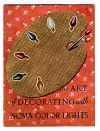 |
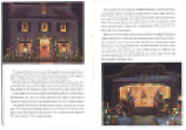 |
||
| This wonderful advertisement was painted in 1922 by Worth Brehm, a prolific book illustrator. Commissioned by General Electric for their Edison Mazda division, the picture is often erroneously attributed to artist Maxfield Parrish who also did many wonderful illustrations for the company. Entitled "His First Christmas", the work was used for only 1 year by General Electric, and then the rights to the painting were sold to the Woodwin Electrical Company, who used it on their boxes of Christmas lights until about 1924. A close-up detail of the charming painting is provided on the far right. | 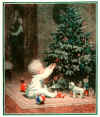 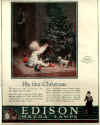
|
|||
| During the early 1920s, moving picture shows featured pre-show advertising slides, just as today's movies do. To the right is a movie slide advertising Edison Mazda tungsten filament lamps. The slides dates to about 1918, when the transition from the "old style " carbon filament to the new and much more efficient tungsten filaments was well underway. At the time, tungsten lamps were about twice the cost of the carbon, and General Electric and the Edison companies were heavily advertising the many benefits of the new material. By about 1920, the buying public had fully embraced the new lamps, and carbon lamps were on their way out. | ||||
| Although not particularly attractive, this NOMA ad is quite important as it discusses (although vaguely) the problems the company had when being accused of producing faulty bubble lights that caused a fire. The ad reinforced the NOMA pledge of safety, and tells of the new chemicals added to their plastic that make it both fire retardant and self extinguishing. By now, we all know that these chemicals were unnecessary, and in fact destroyed the plastic itself within a couple of years. The ad was placed in popular magazines of the time, as well as in trade publications. This particular copy is from a fire fighter's magazine called Fire Engineering, and appeared in the August 1949 issue. | 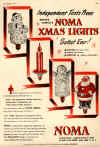 |
|||
| Early appliances and Christmas lights that used the screw-in type connectors often monopolized the only electric tap in the room, until companies like Benjamin and others came to the rescue with multiple adaptors that allowed more than one device to be used at the same time. There was a problem however, in that early house wiring was suitable only for the low current draw of electric lighting and not the new power hungry irons, toasters and the like. Fuse burnouts were a frequent occurrence. |
"Watch out for dear old Santa Claus, tonight he's on his way His pack contains electric irons, and toasters, too, they say... He wasn't agoing to carry them, he was looking like he'd fight, He said you couldn't stick 'em on, unless you lost your light. But yester soon he saw an ad (gaze on his happy mug) He knows that Ma can use her iron and light with a Benjamin Plug!"
|
|
||
|
||||
|
End of Category CLICK HERE FOR THE TABLE OF CONTENTS PAGE AND LINKS TO ALL PAGES ON THIS SITE TABLE OF CONTENTS HISTORY THE TIMELINE MANUFACTURER'S HISTORIES THE PATENT PAGES THE PRE-ELECTRIC ERA VINTAGE ADVERTISING THE LIGHT SET GALLERIES RELATED LINKS
|
||||
|
Note: OldChristmasTreeLights? and FamilyChristmasOnline? are trademarks of Breakthrough Communications? (www.btcomm.com).
|

 | ||||||
| Visit our affiliated sites: | ||||||
| - Christmas Memories and Collectibles - | ||||||
 |

|

|
 |

|
 |
|
| - Family Activities and Crafts - | ||||||
 |

|

|

|

|

|
|
| - Music - | ||||||

|

|
 |

|

|

|
|
| - Trains and Hobbies - | ||||||
 |
 |
 |
 |
 |  |
|

|

|

|  |

|

|
|
